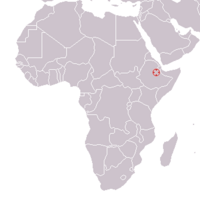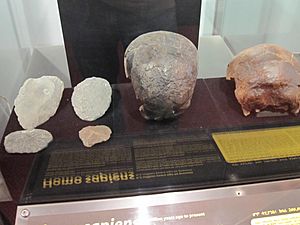Herto Man facts for kids
| Common name | Herto Man |
|---|---|
| Species | Homo sapiens idaltu |
| Age | 157±3 ka |
| Place discovered | Bouri Formation, Ethiopia |
| Date discovered | 1997 |
| Discovered by | Tim D. White and Berhane Asfaw |
Herto Man refers to the very old human remains found in Ethiopia. These fossils are about 154,000 to 160,000 years old. Scientists discovered them in 1997 in a place called the Bouri Formation.
This discovery was very important. At the time, there was a big gap in the human fossil record. This gap was between 300,000 and 100,000 years ago. Herto Man helped fill this missing piece of our history.
When first described in 2003, Herto Man was thought to be the oldest Homo sapiens remains found. Scientists classified it as a new subspecies called Homo sapiens idaltu. Idaltu means "elder" in the local Afar language. It was seen as a link between older human types and modern humans. However, many scientists today do not agree with this classification.
Herto Man made many stone tools. These tools show a mix of old and new styles. They seem to have hunted and butchered large animals like hippos and bovines (like cattle). The skulls of three individuals, including a child, show cut marks. These marks might mean they had special ways of preparing the dead.
Contents
Discovery and Study
Scientists first found Herto Man fossils in 1997. They were discovered in the Upper Herto area of the Bouri Formation. This site is in the Afar Triangle region of Ethiopia.
The fossils found include parts of skulls and teeth. One nearly complete skull belonged to an adult. Another nearly complete skull was from a 6- or 7-year-old child. In total, scientists found remains from at least 12 different individuals.
This part of Ethiopia is famous for ancient human discoveries. Many fossils of early humans and their relatives have been found here. Some go back as far as 6 million years ago.
In 2003, scientists used a special dating method to find the age of the Herto Man fossils. They found them to be between 160,000 and 154,000 years old. This made Herto Man a very important find. It helped scientists understand human evolution during a time when there were few fossils.
Naming Herto Man
In 2003, a team of anthropologists described the Herto Man fossils. Tim D. White and Berhane Asfaw were key members of this team. They believed Herto Man was almost, but not quite, like modern humans. They thought Herto Man was slightly different from any humans living today.
Because of these differences, they gave Herto Man a new subspecies name: Homo sapiens idaltu. The name idaltu means "elder" in the local Afar language. They saw Herto Man as a step between older human types and modern Homo sapiens sapiens.
However, other scientists, like Chris Stringer, questioned this new subspecies name. They thought the Herto Man fossils were similar to other early modern human fossils found elsewhere. Later studies also suggested that Herto Man was very similar to other early modern humans.
The debate about the name idaltu highlights a challenge in science. It is hard to define exactly what makes a "species" or "subspecies." This is especially true when looking at a continuous line of evolution. In such cases, one type of human gradually changes into another over time.
Despite the debate, Herto Man remains very important. It helps us understand how modern humans evolved. It also supports the idea that modern humans first appeared in Africa. This idea is called the "recent African origin model."
Physical Features
The Herto Man skull has features similar to modern humans. It has a high cranial vault, which means a raised forehead. From the side, the skull has a rounded shape. The face is also relatively flat.
The brain size of Herto Man was about 1,450 cubic centimeters. This is similar to the average brain size of modern humans.
However, the Herto skull is also quite strong and thick. It has a noticeable brow ridge above the eyes. The bones at the back of the skull are also strongly curved. Compared to most modern human skulls, the Herto skull is longer and larger overall. But its cheekbones are not very strong.
Way of Life
Tools and Hunting
The area where Herto Man lived was once a freshwater lake environment. Scientists have found many stone tools there. These tools show a mix of different styles.
Some tools were made using the Levallois technique. This method is linked to the "Middle Stone Age" in Africa. Other tools, like cleavers and bifaces, are typical of the older "Acheulean" period. This mix of tools is sometimes called "Transitional Acheulean." It shows that Herto Man used both older and newer tool-making skills.
Herto Man used different types of stone for their tools. They made sharp points and blades from obsidian. Other tools were made from fine-grained basalt. This suggests they knew which materials were best for different tools.
Evidence shows that Herto Man hunted and butchered animals. They mainly hunted hippos, but also bovines. Scientists found many hippo carcasses with cut marks made by tools. This shows that hunting and butchering hippos was a long-standing tradition for them.
Mortuary Practices
The skulls of the adult Herto Man and the child show interesting marks. These marks are not from hunting or accidental injury. They are deep cut marks that suggest the flesh was removed from the skulls.
One adult skull also shows signs of repeated scraping around the braincase. The base of this skull was missing. This might mean the skull was placed there as a separate piece.
The child's skull also had deep cut marks. The base of the skull was broken into, and the edges were polished smooth. This is similar to practices seen in some ancient cultures. These findings suggest that Herto Man might have had special rituals for their dead. They may have prepared the bodies in a symbolic way.
See also
 In Spanish: Homo sapiens idaltu para niños
In Spanish: Homo sapiens idaltu para niños
- Blombos Cave
- Florisbad Skull
- Mumba Cave
- Omo remains
- List of fossil sites
- List of human evolution fossils




